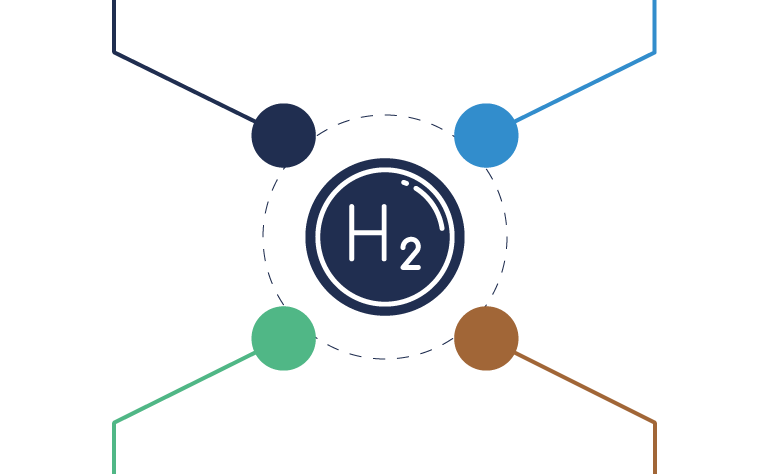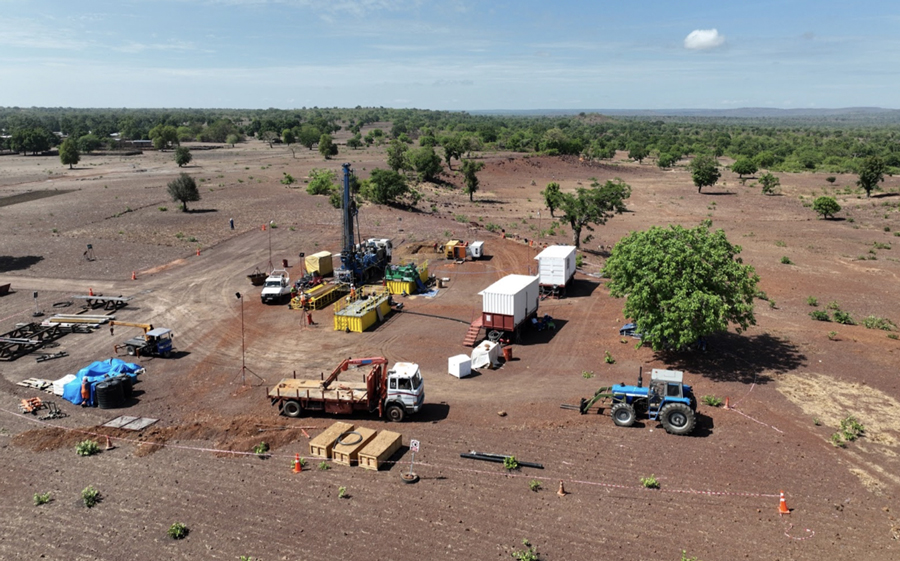NATURAL HYDROGEN
Key figures
0
Volume of CO2 emitted when burned
465
Number of worldwide geo-references containing natural hydrogen occurrences
< 1.5
Estimated production cost of natural hydrogen, in $/kg
98.5%
Concentration in natural hydrogen of the first field currently in production (Mali)
NATURAL HYDROGEN
in a nutshel

It is the most widespread element in the Universe, main constituent of the sun and most of the stars.

Its pure form, di-hydrogen, is created naturally by chemical reactions in the earth’s crust.

It is most often associated with other elements to form molecules (water, methane, starch, sugar, alcohol, etc.).

It is the smallest and lightest element (14 times lighter than air).

Natural hydrogen contains 3 times more energy than gasoline.

In its pure form, di-hydrogen is invisible, odourless and non-toxic.
NATURAL HYDROGEN
in a nutshel
HYDROGEN:
Its main production methods

HYDROGEN:
Its main production methods
THE BENEFIT
of natural hydrogen
LOW CARBON
When burned, hydrogen does not produce carbon but instead only produces pure water. This makes it an environmentally friendly option for meeting our energy needs while reducing carbone missions.
NO EXTRA NEED
The production of natural hydrogen requires neither water nor metals.
CLEAN ENERGY
Production of natural hydrogen is clean. There is no carbon in the chain, no need for anthropogenic electricity nor water and it has a limited footprint for extraction and separation at production sites.
LOW COST
Natural hydrogen will be cheaper than all other forms of proposed H2 production and thus participate in unlocking the hydrogen economy. The very competitive production cost (<1.5$/kg) is reinforced by joint covalorization potential.
SOURCE OF ENERGY
Natural hydrogen is not an energy vector. It is a resource in itself, which do not need to destroy one energy for another. No need of anthropogenic energy or specific raw material.
AVAILABLE WORLDWIDE
There are a variety of geological contexts throughout the world that are favourable to the generation and accumulation of natural hydrogen.
EFFICIENT
Natural hydrogen is an energy-rich fuel, containing three times more energy per unit mass than natural gas. This makes it a promising option for meeting our future energy needs.
EUROPEAN SOVEREINGNTY
Europe has this resource on its soil. Exploratory work is underway in France, Poland, Spain, Romania, the Balkans, etc., and is supported by a European ecosystem of universities and companies that guarantees the control of knowledge and know-how and production on its territory.
RELIABLE
Controllable production because it does not depend on intermittent renewable energy.
SAFE
Natural hydrogen is non-toxic, non polluting, and dissipates quickly These properties make it a reliable and secure option for use in a variety of applications.
NATURAL HYDROGEN
A booming industry
Over the last 5 years, the number of players in the natural hydrogen sector has increased tenfold, and the number of related projects is also booming. The exploratory potential of natural hydrogen is there for all to see, and the players in the sector are working hard to turn exploratory hypotheses – already confirmed by the Hydroma production site in Mali – into industrial projects. A prospect that could well see the light of day by the end of the decade!
The sites where natural hydrogen has been identified are numerous and spread across many countries and almost every continent. These initial geo-referencing results are just the beginning, and the number of identified occurrences and sites with exploratory and production potential continues to grow.
Moreover, even though some forward-thinking scientists began to publish on natural hydrogen and its exploratory potential, research on the subject has really accelerated over the last ten years, if the growth in the number of publications referencing natural hydrogen is anything to go by. This new appeal is helping to structure the industry and gradually dispel some of the assumptions about this still new energy resource.
LITTLE FOCUS ON THE FIRST
NATURAL HYDROGEN PRODUCTION PROJECT WORLWIDE
In 2012, Hydroma launched its pilot project in Bourakebougou, Mali, focusing on the production of electricity from natural hydrogen. The success of this demonstration confirmed the possibility of generating and storing hydrogen naturally with a purity of 98%. The Bourakebougou site has 12 pure hydrogen positive boreholes covering an area of 50 km². A world first, this project has demonstrated the potential of natural hydrogen as a clean energy source.
LITTLE FOCUS ON THE FIRST
NATURAL HYDROGEN PRODUCTION PROJECT WORLWIDE
In 2012, Hydroma launched its pilot project in Bourakebougou, Mali, focusing on the production of electricity from natural hydrogen. The success of this demonstration confirmed the possibility of generating and storing hydrogen naturally with a purity of 98%. The Bourakebougou site has 12 pure hydrogen positive boreholes covering an area of 50 km². A world first, this project has demonstrated the potential of natural hydrogen as a clean energy source.

NATURAL HYDROGEN
The industry’s needs
The members of the AVENIA cluster’s earth2 programme are confident about the resource’s potential and its imminent and significant contribution to our energy mix. However, the resource is still given far too little consideration, despite its promise. It was with this in mind that the earth2 programme was set up to help raise the profile of the sector and obtain support at various levels.





